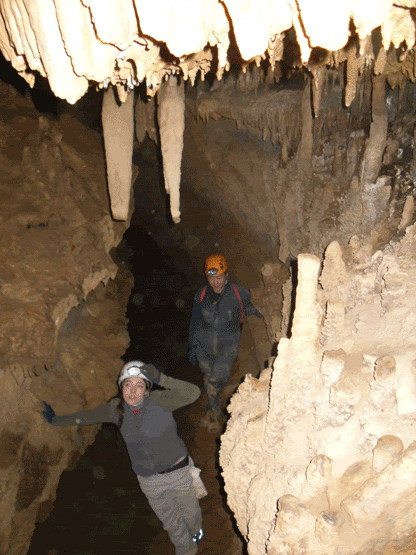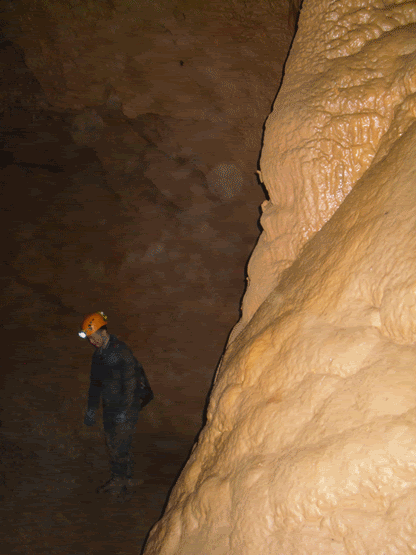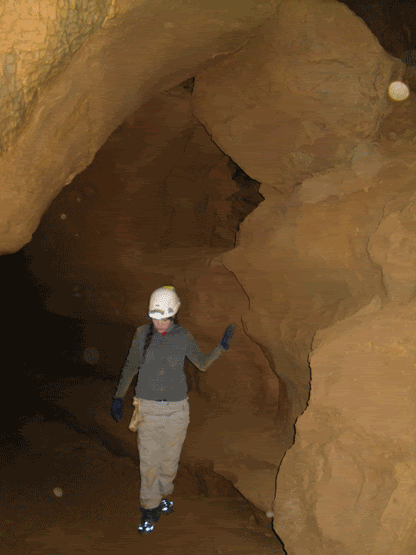


Highland County, Virginia is a hotbed of cave exploration. Home to some of the longest caves in the state, the Chestnut Ridge cave systems and the systems of Burns Cove move massive amounts of water. And I do mean massive. The Butler-Sinking Creek system is now recorded to be seventeen miles long, and the related Chestnut Ridge System is fourteen miles long. The two are related hydrologically, as is nearby Aqua-Lockridge, and on the other side of the mountain is the Water Sinks System which is thought to possibly be a major contributor to the fridgid waters of Aqua, also known as Refrigerator Spring. Across the Cowpasture River is a small trail about a mile long that leads to one of my favourite places under-ground, called Marshall's Cave. When pondering the caving possibilities for the Boston Grotto/MIT caving trip back in February, this cave was one of the first that came to mind. I had last visited the cave about fifteen years prior, right before I left for college with my friend Christian, and I remembered being impressed with the absolute scale of the formations and the picturesque cave passages. This is not the longest cave I had ever been in, but it certainly was the most formated and large, complex horizontal caves I had ever been in.
After an evening of recovering from the Valentine's Day adventure of Site's Cave, and late evening debacle of locating Cave Rat Cave, finding out that we couldn't get into Cave Rat Cave through the horizontal entrance so aborting the trip instead of a hike in snow flurries to Kee's Cave in Franklin, this I felt would be the crowning jewel of our trip into the heart of West Virginia caving. True, Sites was very challenging from the technical aspect of rappelling and ascending out, but this cave would give us a good work out, and give me a chance to strech out my legs.

Genita and Darren had left us the night before, so it was just down to Keluo, Amy, and Madeleine who had joined us later the previous afternoon. We drove the thirty or so odd miles down a non-descript country road to the Bull Pasture Recreational Area near Williamstown, Virginia. Following the Cow Pasture River, you could smell cave, and the weather was quite mild, in the fifties, compaired to our weather back home in Massachusetts and New Hampshire.
After locating the parking area, and gearing up, we headed across the suspension bridge to the far side of the river, and picked up the trail to the cave. The cave is not readily spotted since it sits high on a talus slope overlooking the river, and the only indication that you are close is when the trail crosses over a spring (which is the resurgence for the stream in the lowest level of the cave). Spotting the talus slope, we all turned up the faint trail. People do come to this cave, but my guess is that it is fairly infrequent. I have NEVER seen another group of cavers in it, and when I mention the name of Marshall's Cave, I usually get blank looks from many Virginia cavers. Either is it forgotten by most, or they just don't know about it.

Amy and Madeleine lead the way into the cave, stopping to take pics of the small brown cave spiders that have made their home in the entrance area (for the squeamish, they are really small, and if you weren't looking for them, you would never really notice them). The passage is made up of grey limestone...even the formations are grey, and what formations are there, they have been broken off by vandals. However, we didn't come here to see the broken ones, and shortly we made our way through a few narrow squeezes before arriving at the pits that lead down to the middle level. Fifteen years ago I remember breaking out the ropes and rack to rappell down the twenty-five foot deep holes, but after a little investigation, the use of vertical equipment would be of no use, so we left the rope behind.
After this easy climb-down is where you first encounter the first major obstacle of Marshall's cave. Water. The water is so still that it is hard to discern where the water actually starts. But it is also here where Marshall's true beauty starts to show itself. The formations are active, still receiving the mineral laden water that slowly builds them up. The passage is a narrow canyon passage that you have to traverse by putting your feet on the opposite walls and "walk" across, hoping not to get into the cold water. This is easier said than done, as the formations partially block the passage, causing you to sometimes bridge yourself across, duck under formations, and occasionally climb...all while trying not to fall in. Keluo was the first casualty of the trip when he attempted a duck under that brings your face within a couple feet of the water, and his foot slipped and ended up thigh deep.
On about three occasions you reach a formation choke in the passage, and the only way to continue is up the wall, some of them with tricky hand and foot holds. For someone whi is trying to learn various chimneying and non-rope based technique, this cave is quite fun and offers opportunities for you to stretch yourself. Finally, after this third formation choke, and climb up the wall, there is a fifteen foot drop that you don't want to go down, and building up the confidence that you can do it, and your dependency upon friction can be a little disturbing at first, but not too difficult.

After crossing the drop, there is a climb down to the big part of the cave. It is a fairly tall canyon passage full fo large formations, mostly columns and flowstone that reach forty feet to the ceiling. Following this passage back, we spent quite a bit of time photographing the formations and the occasional bat. The passage quickly goes from walking to stooping, and then finally it appears to end. I remember fifteen years ago that there was a gypsum flower (a formation where the gypsum, usually a mineral of drier caves, almost seems to have been extruded from the rock like toothpaste) but it is gone. This could be due to increased moisture in the cave or, more likely, someone decided to take it home (where it turned into disappointing dust most likely).
To the rest of the group it almsot seemed like a disappointment...we had reached the end of the cave. Not quite ;) We turned around and headed back toward the entrance. Part way back the passage, I asked the group to stop and look by their feet. There was a small opening that lead into blackness. This is the entrance to the lowest level of the cave. After Amy slipped into the darkness, the rest of us followed, and then slid down to the bottom. It is here that the ceiling are really high, a good estimate is about seventy-five feet or so. It is also here that there is the stream that resurfaces at the spring that we crossed on the way in. Amy and Madeleine disappeared among the formations toward the back of the room. Keluo and I took some photos and I took the time to change my batteries. I was trying to encourage the group to take a sip from the stream, going against all presuppositions that one shouldn't drink unless it is from a tap, but it is the sweetest, cleanest tasting water I have ever had.




Marshall's Cave is located in the recreational area near Williamstown, Virginia. Though horizontal and following in pretty much a straight line so it would be difficult to get lost. However, that being said, please do not go caving unless you are with a minimum of three people, three independant sources of light and at least the basics of caving gear. If interested, please get in contact with your nearest grotto, or if you have any caver friends. The last I knew, this cave is currently closed due to federal and local governments folling the recommendations for the protection of bats from White Nose Syndrome. Though this is not a "bat cave" per se, it is the policey of many places that no one enter the cave to prevent the spread of this tragic condition afflicting our bats. As a caver, it is our responsibility to be like the Lorax and speak for the bats. We were very fortunate to have been able to get in the caving that we did in West Virginia and Virginia when we did since they closed the caves shortly thereafter. There are caves that are open, please check available web resources and with local grottos (caving clubs) to get information on what caves are available for entry.



7 comments:
Hi I love marshalls cave and I was hoping to up there during spring break in a couple weeks. I haven't been back there since my caving days in high school. I was wondering if you know or if you could point me in the right direction to find out if it is closed currently. Thanks Ivan
Ivan,
The cave is on the Property of the Bullpasture Recreational Area which I believe is owned by the State. The current recommendation by the Department of Natural Resources is that the caves in general remain closed until the summer and the hibernation period has ended (since as you know, White Nose Syndrome is a major factor and any disruption to the hibernation cycle is devastating). That being said, Marshall's is not a major hibernaculum so the roosting bat population is minimal. I know that people ARE caving actively in the area. The temperatures down there may also be high enough that the bats are active already or just beginning to. But as to it being on an official closure list, it is not (probably since it doesn't get much pressure). Hope you find this info useful!
And yeah, its a great cave!
BTW, just doing my part to be the Lorax and speaking for the bats, check with the Federal Wildlife Service's recommendations for decontamination of gear before going!
You can find it here:
http://www.fws.gov/whitenosesyndrome/pdf/WNS1pageDecontaminationProtocol_073110.pdf
Thanks for the info I will try to see what I can find out. Its a great cave decently technical for a horizontal cave and plenty of interesting things to look at. I have fond memories of swimming in the river after trips. Also I was wondering if you have ever been in Aqua the one just across the road from Marshalls? I always wanted to check that out but I never got around to more than staring at the water pouring out. Do you know anything about it or when the best time to get in there is?
I remember going spelunking in high school with a camp group (around 90-91). We went to several caves in va/wva. I think one was near Cowpasture River. I recognize the pic of the bridge in this post. I do not think it was marshall cave though because I remember to get into the cave we had to swim in 40 degree water (in the middle of the summer) and dive under a ledge. I remember the guide said it was one of the sources of the james river. We could hear a water fall in the distance. He then started to show signs of Hyperthermia so we got out of it pretty quick. Anyone know anything about this cave?
You are referring to Aqua Cave, hypothesized to be part of either the Butler Sinking Creek System or a resurgence for the Water Sinks System on the other side of the mountain. I have never been in there, but it has both a dry and a wet part. Yeah, the water is absolutely frigid! When I am down there this summer I may take the opportunity to pop into it at least (but with a wetsuit)
It has been 30 years since I have been through Marshall Cave. I can remember reaching the end of the cave and finding a wall of sea shell fossils. Too cool!
Post a Comment